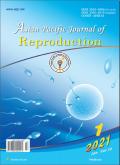A novel herbal combination ameliorates ovarian dysfunction and regulates altered biochemical parameters in rats with letrozole-induced polycystic ovary syndrome
IF 0.6
Q4 REPRODUCTIVE BIOLOGY
引用次数: 0
Abstract
Objective: To investigate the potential activity of novel herbal combination and novel herbal formulation (syrup) in female Sprague Dawley rats with letrozole-induced polycystic ovary syndrome (PCOS). Methods: Forty-two rats were randomly divided into seven groups with six rats in each group. Group 1 received 0.5% carboxy methylcellulose orally for 37 days and served as the normal control group. Group 2 was orally administered with letrozole of 1 mg/kg for 21 days and served as the PCOS induction group without treatment. Group 3 to 7 were administered with letrozole of 1 mg/kg for 21 days orally to induce PCOS, and then respectively received clomiphene citrate at 1 mg/kg, 100 and 200 mg/kg of novel herbal combination, 200 mg/kg of novel herbal formulation (syrup), and 400 mg/kg of marketed formulation of Pushyanuga churna, once daily for 15 days. Effects of the novel herbal combination and its syrup formulation were evaluated on the hormonal profile, the levels of antioxidants, the lipid profile and on the ovarian morphology, using letrozole-induced PCOS model in rats. Results: Letrozole caused alterations in hormonal levels and lipid levels similar to PCOS and ovarian histology showed presence of ovarian cysts confirming the induction of PCOS in rats. On treatment with the novel herbal combination and its syrup formulation in PCOS-induced rats, the altered hormonal and lipid profiles showed significant recovery to normal levels. Ovarian histology confirmed the restoration of folliculogenesis in the PCOS-induced rats. The treatment with the syrup formulation of novel herbal combination was found to be more effective than novel herbal combination and showed better recovery in various parameters evaluated. The results of the study, however, suggested that treatment with novel herbal combination and its syrup formulation provided minimal protection against oxidative stress caused due to the induction of PCOS. Conclusions: The integrated approach for management of PCOS is to counterbalance the limitations associated with modern therapy. Both the novel herbal combination and the syrup formulation of novel herbal combination show efficacy in the management of PCOS in rats and restore folliculogenesis in the ovary. The syrup formulation of novel herbal combination is most effective in the management of PCOS and shows potential to be developed as an adjuvant therapeutic agent.一种新的草药组合改善来曲唑诱导的多囊卵巢综合征大鼠的卵巢功能障碍并调节其改变的生化参数
目的:研究新草药组合和新草药制剂(糖浆)对来曲唑诱导的多囊卵巢综合征(PCOS)雌性Sprague-Dawley大鼠的潜在活性。方法:将42只大鼠随机分为7组,每组6只。第1组口服0.5%羧甲基纤维素37天,作为正常对照组。第2组口服来曲唑1mg/kg,持续21天,作为不治疗的PCOS诱导组。第3至第7组口服1 mg/kg的来曲唑21天以诱导PCOS,然后分别接受1 mg/kg、100和200 mg/kg的新型草药组合、200 mg/kg的新草药制剂(糖浆)和400 mg/kg的Pushyanuga churna市售制剂的克罗米芬柠檬酸盐,每天1次,持续15天。使用来曲唑诱导的大鼠多囊卵巢综合征模型,评估了新草药组合及其糖浆制剂对激素水平、抗氧化剂水平、脂质水平和卵巢形态的影响。结果:来曲唑引起的激素水平和脂质水平的变化与多囊卵巢综合征相似,卵巢组织学显示存在卵巢囊肿,证实了大鼠多囊卵巢综合症的诱导。在PCOS诱导的大鼠中,用新的草药组合及其糖浆制剂治疗时,激素和脂质的变化显示出显著恢复到正常水平。卵巢组织学证实多囊卵巢综合征诱导的大鼠卵泡发生恢复。新草药组合的糖浆制剂的治疗被发现比新草药组合更有效,并且在评估的各种参数中显示出更好的回收率。然而,研究结果表明,使用新型草药组合及其糖浆制剂进行治疗,对PCOS诱导引起的氧化应激的保护作用微乎其微。结论:多囊卵巢综合征的综合治疗方法是平衡现代治疗的局限性。新草药组合和新草药组合的糖浆制剂均显示出对大鼠多囊卵巢综合征的治疗和恢复卵巢卵泡生成的疗效。新型草药组合的糖浆制剂在多囊卵巢综合征的治疗中最有效,并显示出作为辅助治疗剂开发的潜力。
本文章由计算机程序翻译,如有差异,请以英文原文为准。
求助全文
约1分钟内获得全文
求助全文
来源期刊

Asian Pacific Journal of Reproduction
Veterinary-Veterinary (all)
CiteScore
1.70
自引率
0.00%
发文量
588
审稿时长
9 weeks
期刊介绍:
The journal will cover technical and clinical studies related to health, ethical and social issues in field of Gynecology and Obstetrics. Articles with clinical interest and implications will be given preference.
 求助内容:
求助内容: 应助结果提醒方式:
应助结果提醒方式:


